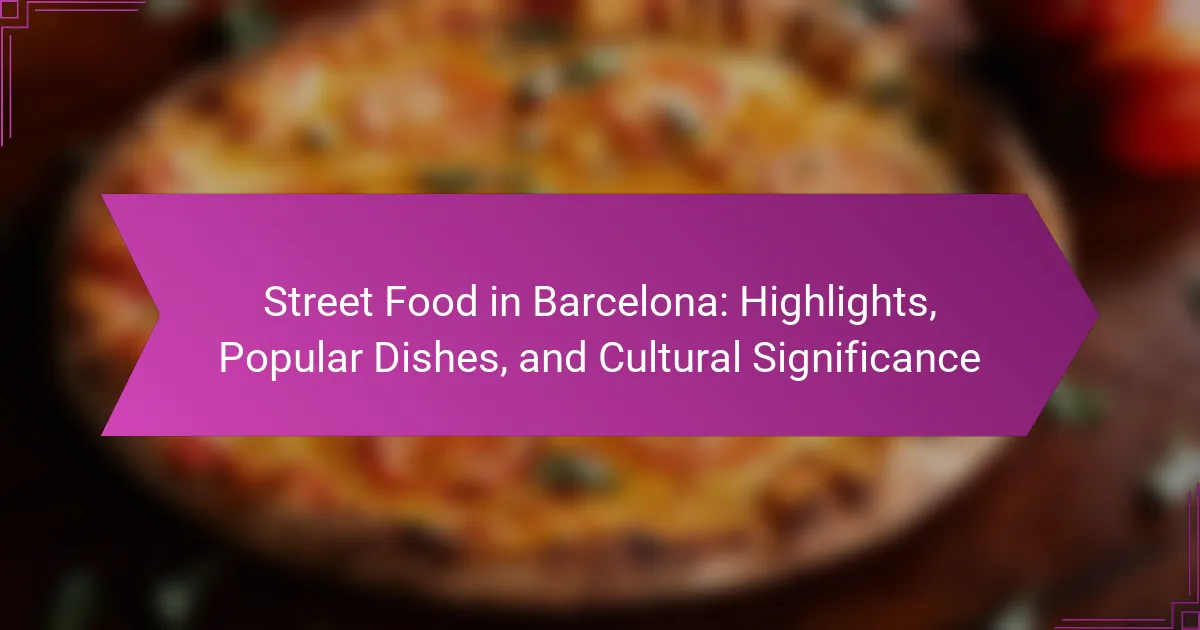Tapas culture in Madrid offers a unique dining experience that emphasizes sharing and community. Explore traditional dishes like patatas bravas and jamón ibérico, discover the social dynamics of tapas gatherings, and find the best locations to enjoy this vibrant culinary scene. From bustling taverns to modern bars, Madrid’s tapas reflect a rich blend of local flavors and communal enjoyment.
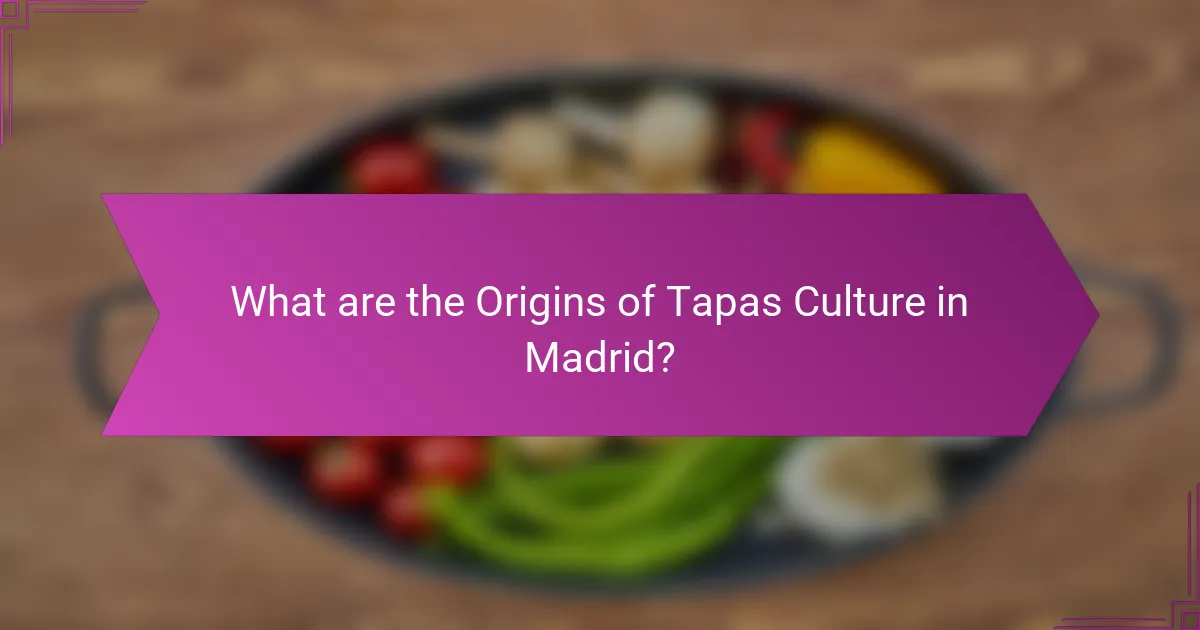
What are the Origins of Tapas Culture in Madrid?
Tapas culture in Madrid originated from the practice of covering drinks with small plates of food, known as “tapas.” This tradition evolved in the 19th century, reflecting social gatherings and local flavors. Tapas encourage sharing and foster community, making them integral to Madrid’s culinary identity. Traditional dishes include patatas bravas and jamón ibérico, while popular locations feature bustling taverns and modern bars. The unique aspect of tapas culture is its variety, offering countless combinations that cater to diverse tastes.
How Did Tapas Evolve Over Time?
Tapas evolved from simple snacks served with drinks to a vibrant culinary tradition in Madrid. Initially, tapas were meant to cover drinks, preventing flies from contaminating them. Over time, they transformed into diverse dishes, reflecting regional ingredients and cultural influences.
In the 20th century, tapas became a social phenomenon, encouraging communal dining and interaction. The rise of tapas bars in Madrid popularized this culture, making it a staple in social gatherings. Today, tapas showcase a variety of flavors, from traditional patatas bravas to modern interpretations, symbolizing Madrid’s dynamic food scene.
The unique attribute of Madrid’s tapas culture is its emphasis on social interaction, as sharing small plates fosters a communal dining experience. This aspect distinguishes it from other culinary traditions globally.
What Influences Shaped Traditional Tapas?
Traditional tapas in Madrid are shaped by historical influences, regional ingredients, and social customs. The Moorish occupation introduced spices and cooking techniques, while local agriculture contributed fresh produce. Socially, tapas encourage communal dining, fostering connections among friends and family. This cultural practice promotes sharing and tasting a variety of dishes, enhancing the overall dining experience. Additionally, the evolution of tapas reflects Madrid’s diverse culinary landscape, incorporating influences from neighboring regions and international cuisines.
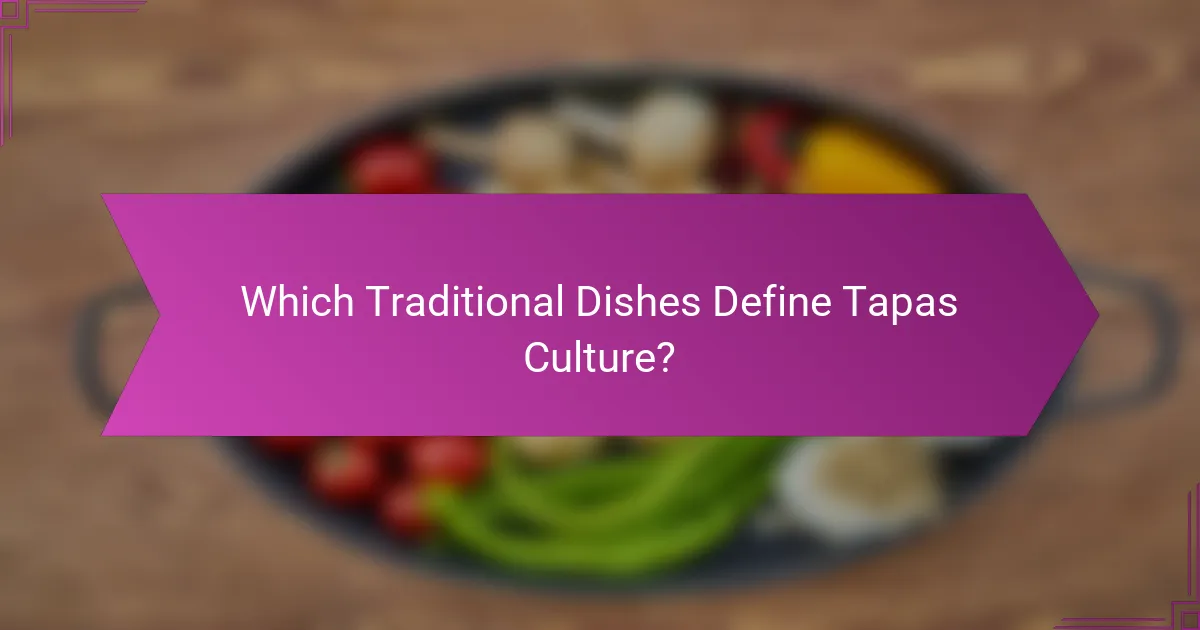
Which Traditional Dishes Define Tapas Culture?
Traditional dishes that define tapas culture in Madrid include patatas bravas, jamón ibérico, and tortilla española. These dishes emphasize social dining and shareable portions, fostering a communal atmosphere. Each dish offers distinct flavors, contributing to the vibrant culinary scene. Popular locations to experience these tapas include La Casa del Abuelo and Mercado de San Miguel, where both locals and tourists enjoy authentic flavors.
What Are the Most Popular Tapas Dishes in Madrid?
The most popular tapas dishes in Madrid include patatas bravas, jamón ibérico, and tortilla española. These dishes reflect the city’s vibrant culinary culture and social dining traditions.
Patatas bravas consist of fried potatoes served with a spicy tomato sauce. Jamón ibérico is a cured ham known for its rich flavor and texture. Tortilla española is a Spanish omelet made with eggs and potatoes, often enjoyed as a hearty snack.
Other notable tapas include croquetas, which are creamy fritters filled with various ingredients, and gambas al ajillo, garlic shrimp sautéed in olive oil. These dishes are commonly found in local bars and restaurants, making them integral to the Madrid tapas experience.
How Do Ingredients Vary Among Different Tapas?
Ingredients in tapas vary widely based on regional influences and traditional recipes. Common ingredients include olives, cheese, cured meats, seafood, and vegetables. For instance, Madrid’s tapas often feature chorizo and jamón ibérico, while coastal areas might emphasize fresh fish. Unique attributes like the use of seasonal produce also play a role in ingredient variation. Additionally, some tapas may incorporate rare ingredients like octopus or exotic spices, reflecting local culinary traditions. This diversity enhances the social experience of sharing and enjoying tapas in Madrid.
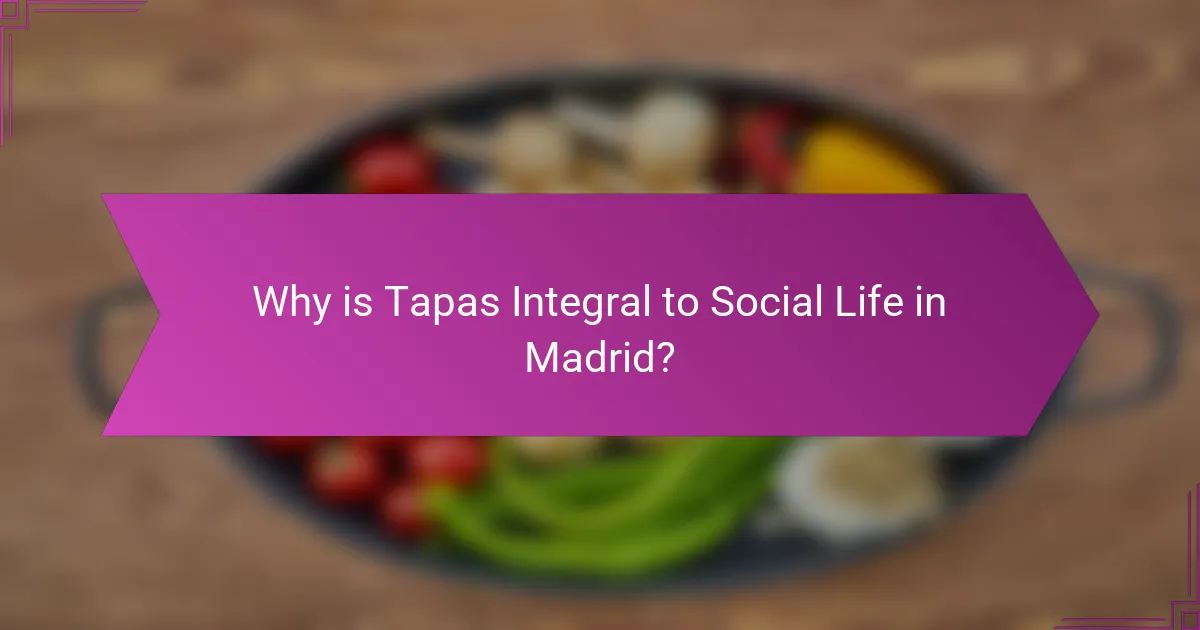
Why is Tapas Integral to Social Life in Madrid?
Tapas are integral to social life in Madrid because they foster community and connection. Sharing small plates encourages conversation and interaction among friends and family. The tradition of going out for tapas, known as “tapeo,” creates a vibrant social atmosphere in local bars and restaurants. Popular dishes like patatas bravas and jamón ibérico not only highlight the region’s culinary diversity but also serve as conversation starters, enhancing social bonds. The communal experience of enjoying tapas contributes significantly to Madrid’s cultural identity and social dynamics.
How Do Tapas Foster Community and Interaction?
Tapas foster community and interaction by encouraging shared dining experiences. These small dishes promote conversation and connection among diners, creating a social atmosphere. In Madrid, tapas culture thrives in vibrant bars and restaurants, where people gather to enjoy food together. This communal aspect enhances social bonds and fosters a sense of belonging within the community.
What Role Do Tapas Play in Celebrations and Gatherings?
Tapas play a vital role in celebrations and gatherings by fostering social interaction and enhancing culinary experiences. These small dishes encourage sharing and conversation, making them ideal for communal dining. In Madrid, tapas culture thrives during festivals and family gatherings, where traditional dishes like patatas bravas and jamón ibérico create a vibrant atmosphere. The unique attribute of tapas is their variety, offering something for every palate and occasion. Additionally, popular locations such as La Latina and Malasaña provide a lively backdrop for enjoying these dishes, further enriching the social experience.
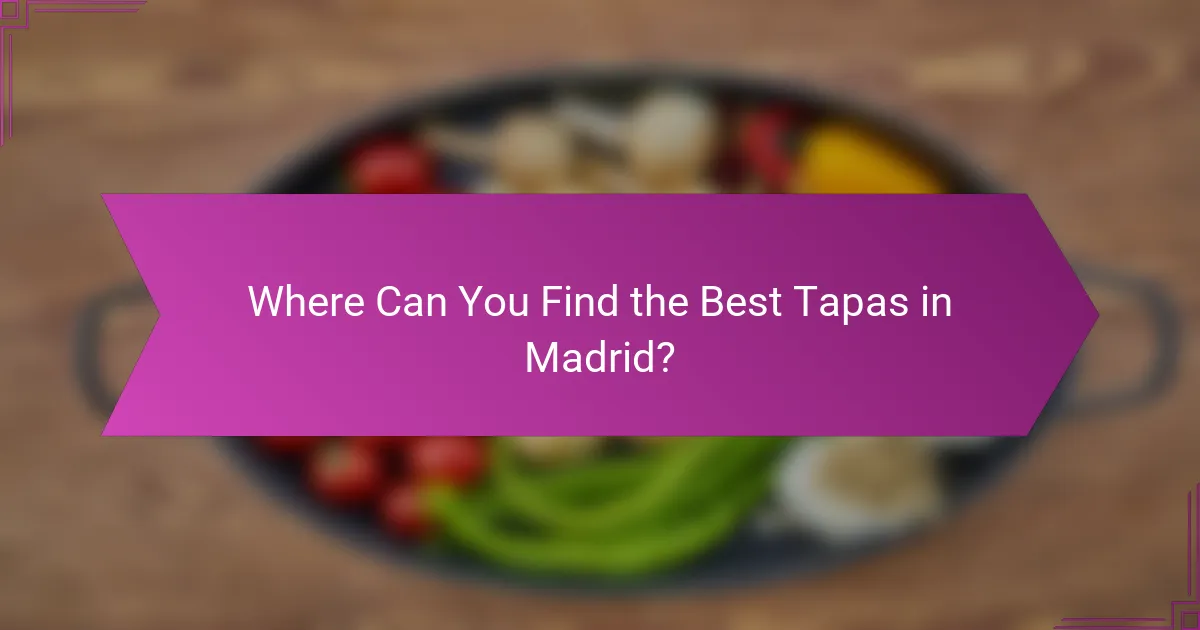
Where Can You Find the Best Tapas in Madrid?
The best tapas in Madrid can be found in various traditional bars and restaurants. Notable locations include La Casa del Abuelo, renowned for its garlic shrimp, and El Tigre, famous for generous portions. Additionally, Mercado de San Miguel offers a vibrant atmosphere with diverse tapas options. Visitors can also explore Cava Baja, a street lined with tapas bars showcasing local specialties. Each venue reflects the rich tapas culture, emphasizing social dining and sharing.
What Are the Must-Visit Tapas Bars and Restaurants?
Some must-visit tapas bars and restaurants in Madrid include La Casa del Abuelo, known for its shrimp tapas, and El Tigre, famous for generous portions. Other top spots are Casa Lucio, celebrated for its huevos rotos, and Taberna El Sur, offering a cozy atmosphere with traditional dishes. Mercado de San Miguel is a vibrant market featuring various tapas vendors, providing a unique culinary experience. Each location showcases Madrid’s rich tapas culture through diverse dishes and social dining experiences.
How Do Locations Differ in Their Tapas Offerings?
Locations in Spain differ significantly in their tapas offerings, influenced by regional ingredients and traditions. In Madrid, traditional tapas include patatas bravas and jamón ibérico, reflecting the city’s culinary heritage. In contrast, coastal regions like Andalusia feature seafood tapas, such as fried fish and grilled octopus. Each area also emphasizes social dining experiences, with local bars fostering communal eating. This regional diversity enriches Spain’s tapas culture, showcasing unique flavors and social practices.

How Do Cultural Events Influence Tapas Trends?
Cultural events significantly shape tapas trends by introducing new flavors and dining experiences. Festivals and local celebrations in Madrid often feature traditional tapas alongside innovative variations. This blend of old and new attracts both locals and tourists, fostering a vibrant culinary scene. Seasonal events can also highlight specific ingredients, influencing menu offerings and encouraging chefs to experiment. The social aspect of sharing tapas during these events promotes community engagement and culinary exploration, further enhancing Madrid’s tapas culture.
What Festivals Celebrate Tapas in Madrid?
Madrid celebrates tapas through various festivals that highlight its culinary culture. Notable events include the Tapas Fair in the Chamberí district, which showcases local bars and their signature dishes. The Madrid Fusion Gastronomy Summit also features innovative tapas creations by renowned chefs. Additionally, the San Isidro Festival celebrates traditional Spanish tapas alongside music and dance, fostering community engagement. These festivals emphasize the social aspect of tapas, bringing people together to enjoy diverse flavors and experiences.
How Do Seasonal Ingredients Affect Tapas Menus?
Seasonal ingredients significantly enhance tapas menus by introducing fresh flavors and promoting local produce. In Madrid, tapas often reflect the seasons, with spring featuring asparagus and summer highlighting tomatoes. This practice supports sustainability and reinforces local culinary traditions. Seasonal variations also encourage creativity among chefs, leading to unique dishes that celebrate the region’s agricultural diversity. Seasonal menus can also attract diners seeking authentic experiences, fostering a deeper connection to Madrid’s vibrant food culture.

What Unique Tapas Experiences Can You Discover?
Unique tapas experiences in Madrid include immersive culinary tours, rooftop dining with local wines, and interactive cooking classes. These activities enhance the social aspect of tapas culture, allowing participants to engage with chefs and fellow food enthusiasts. The city’s vibrant atmosphere complements traditional dishes like patatas bravas and jamón ibérico, making each meal memorable. Exploring hidden gems in neighborhoods such as La Latina and Malasaña reveals rare tapas offerings that showcase regional ingredients and innovative flavors.
Which Innovative Tapas Concepts Are Emerging?
Innovative tapas concepts are emerging in Madrid, focusing on fusion flavors and sustainable ingredients. Chefs are blending traditional Spanish recipes with international cuisines, creating unique dishes. For instance, tapas featuring Asian spices or Middle Eastern influences are gaining popularity. Additionally, restaurants prioritize local sourcing, enhancing freshness and supporting regional farmers. These trends reflect a modern twist on the traditional tapas culture while maintaining social dining experiences.
How Do Fusion Tapas Reflect Modern Culinary Trends?
Fusion tapas reflect modern culinary trends by blending traditional Spanish flavors with global influences. This approach enhances creativity and encourages experimentation in dining. Chefs often incorporate diverse ingredients, resulting in innovative dishes that appeal to contemporary palates. For instance, a classic patatas bravas may be reimagined with Asian spices or served with a unique dipping sauce. This evolution fosters a vibrant social dining experience, where sharing and tasting different cultures becomes central to the tapas culture in Madrid.

What Common Mistakes Should You Avoid When Enjoying Tapas?
To enjoy tapas in Madrid, avoid over-ordering, neglecting local specialties, and skipping the social aspect. Prioritize sharing small plates with friends to enhance the experience. Be mindful of timing; tapas are best enjoyed leisurely. Don’t forget to pair dishes with appropriate wines for a complete culinary experience.
How Can You Pair Drinks with Tapas Effectively?
To pair drinks with tapas effectively, consider complementary flavors and textures. Wine, beer, and cocktails can enhance the tapas experience. For example, a crisp white wine pairs well with seafood tapas, while a robust red suits meat dishes. Local Spanish wines, such as Rioja, are popular choices. Additionally, refreshing cocktails like sangria can balance rich flavors. Understanding the unique attributes of each dish helps in making informed pairing decisions.
What Etiquette Should You Follow in Tapas Bars?
In tapas bars, maintain a casual and friendly demeanor while respecting local customs. Greet staff politely and wait to be seated. Share dishes and avoid ordering too much at once to embrace the communal dining spirit. It’s customary to enjoy drinks alongside tapas, so order accordingly. Tipping is appreciated but not obligatory; rounding up the bill suffices.
What Tips Can Enhance Your Tapas Experience?
To enhance your tapas experience in Madrid, focus on trying a variety of dishes, sharing with friends, and visiting local bars. Explore traditional options like patatas bravas and jamón ibérico. Pair your food with local wines or a refreshing sangria. Engage with locals for recommendations on hidden gems. Timing matters; visit during peak hours for a lively atmosphere.

